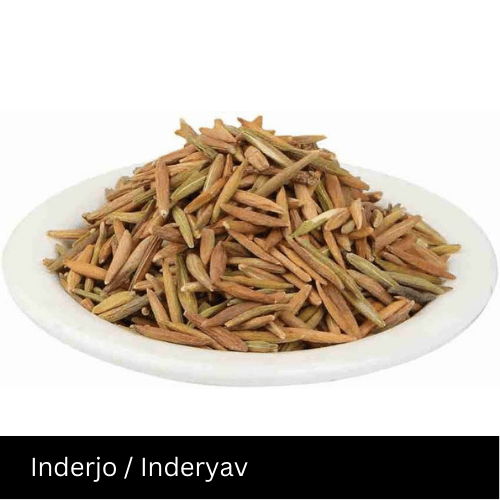About Inderjo – Inderyav / Holarrhena Pubescens
The bark of the Inderjo tree contains alkaloids such as conessine, holarrhine, and machine, which have been found to have antimalarial and antitumor properties. The bark is also used in traditional Ayurvedic medicine to treat various ailments such as diarrhea, dysentery, and fever.
The leaves of the Inderjo tree are used to treat skin diseases such as eczema, psoriasis, and leprosy. The seeds of the tree are used as a natural pesticide, and the wood is used in construction and for making furniture.
Inderjo has also been studied for its potential use in the treatment of diabetes, as the bark extract has been found to have hypoglycemic effects.
Overall, Inderjo is a valuable tree species with various medicinal and practical uses, and it continues to be an important part of traditional medicine in India and Southeast Asia.
- Kurchi
- Tellicherry bark
- Conessi bark
- Vatsaka
- Kutaja
- Kodagu
- Kodangal
- Koduga
- Kodugu
- Kuda
- Kuda-Maram
- Kutajamu
- Kuta
- Kutaja ghanavati
- Kutajghan
- Kurchi bark
- Pala indigo tree
- Dita bark
- Dita tree
- Holarrhena antidysenterica
These names are used in different regions of India and other countries where Inderjo is found. The plant is highly valued for its medicinal properties and is used in traditional medicine to treat various ailments.
-
Antimalarial Properties: Inderjo contains alkaloids that have been found to have antimalarial properties. The bark extract is traditionally used to treat malaria.
-
Antitumor Properties: The alkaloids in Inderjo have also been found to have antitumor properties, making it a potential treatment for cancer.
-
Digestive Disorders: Inderjo is traditionally used to treat digestive disorders like diarrhea and dysentery.
-
Skin Disorders: The leaves of the Inderjo tree are used to treat skin diseases such as eczema, psoriasis, and leprosy.
-
Hypoglycemic Effects: Inderjo has been studied for its potential use in the treatment of diabetes, as the bark extract has been found to have hypoglycemic effects.
-
Anti-inflammatory Properties: Inderjo has anti-inflammatory properties that make it useful in the treatment of inflammation-related conditions like arthritis.
-
Antimicrobial Properties: The bark extract of Inderjo has antimicrobial properties, making it useful in treating infections caused by bacteria and fungi.
-
Antiulcer Properties: Inderjo has been found to have antiulcer properties, making it useful in the treatment of ulcers.
-
Natural Pesticide: The seeds of the Inderjo tree are used as a natural pesticide, making it an eco-friendly alternative to chemical pesticides.
-
Construction Material: The wood of the Inderjo tree is used in construction and for making furniture, making it a valuable natural resource.
Overall, Inderjo has a range of medicinal and practical benefits, making it an important tree species in India and Southeast Asia.
It is important to note that while there may be other plants with similar names, the specific benefits and uses discussed for Inderjo refer to Holarrhena pubescens. It is important to verify the scientific name of a plant to ensure that the correct plant species is being used for its intended purpose.
-
Alkaloids: Inderjo contains several alkaloids, including conessine, kurchine, holarrhimine, and holarrhine, which are responsible for many of the plant’s medicinal properties.
-
Triterpenoids: Inderjo contains triterpenoids, such as lupeol and betulin, which have anti-inflammatory and antimicrobial properties.
-
Flavonoids: Inderjo contains flavonoids, such as kaempferol and quercetin, which have antioxidant and anti-inflammatory properties.
-
Sterols: Inderjo contains sterols, such as β-sitosterol and stigmasterol, which have cholesterol-lowering properties.
-
Glycosides: Inderjo contains glycosides, such as kut kin and outside, which have hepatoprotective (liver-protective) properties.
-
Coumarins: Inderjo contains coumarins, such as scopoletin, which have anti-inflammatory and antimicrobial properties.
-
Essential oils: Inderjo contains essential oils, which have antimicrobial and insecticidal properties.
These chemical compounds work together to provide Inderjo with a range of medicinal properties, including antimalarial, antitumor, hypoglycemic, anti-inflammatory, and antimicrobial effects.

